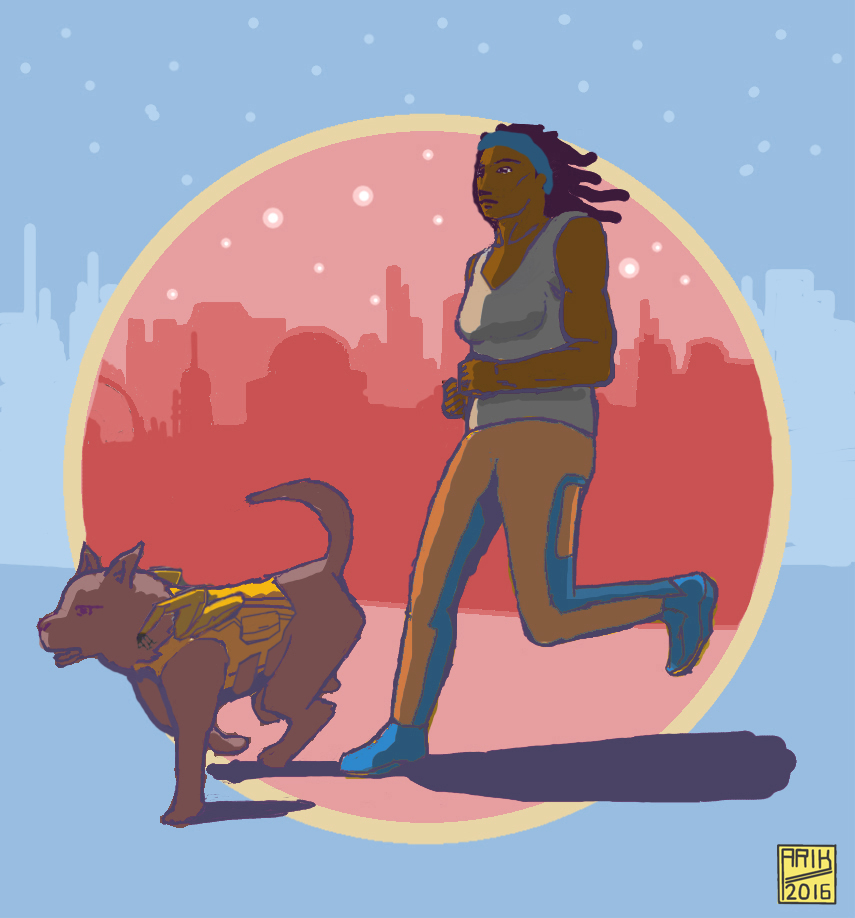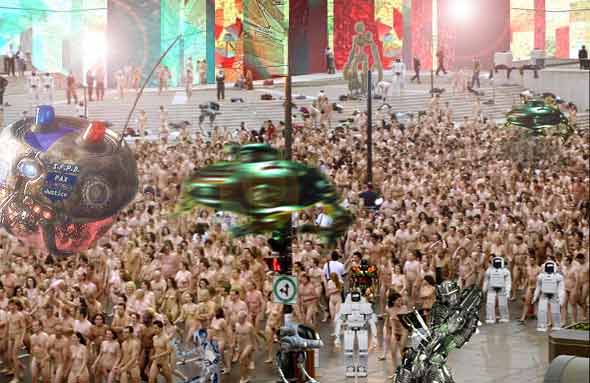BY LETTER
Baseline Human
 Image from Arik | |
| A baseline human runs with their canine friend | |
While most humans embraced the possibilities opened up by gengineering from the Interplanetary Age onwards, there were a minority who remained unaltered long after the Great Expulsion. The reasons for this are varied; in some cases the people in question ended up in regions where they were disenfranchised and exploited, or they had religious reasons for declining to augment themselves, or simply feared the process of change.
From the First Federation onwards, it became common to classify citizens by their physical characteristics for census purposes, as this information could be used to better meet their needs. The distinction between Baseline and Nearbaseline humans came about because the former were at a serious disadvantage in the scarcity-based economies that still predominated at the time, and often could not afford to enhance themselves in order to compete. Taxes raised from Megacorp profits were used to fund public enhancement clinics across Federation territory, making genetic enhancement affordable for the first time since the early Interplanetary Age, and common cybernetic mods like DNI surgery and medisystem injections were also subsidised.
As a result of these policies, Baseline humans became increasingly rare. Those who hadn't had the opportunity to purchase genemods for themselves and their children did so as soon as they could, while conservatives found themselves unable to justify the shorter lifespan and reduced intelligence that were features of the Baseline genome. Only isolated populations like the Christians of Pacifica and the Quarks of Corona managed to survive in their Baseline form, either for religious reasons or because they were able to carve out a niche for themselves as a tourist attraction. Many more Baselines left the Inner Sphere worlds shortly after the Consolidation Wars, setting up numerous colonies along what was then the Periphery, some of which may remain undiscovered to this day.
Metasoft's Baseline reserves have been crucial in preserving this endangered species, as by the time of their founding just after the Version War, almost all 'Baselines' were found to have at least some genetic enhancements, added by one of their ancestors and unknown to their descendants. Had they not drawn attention to this issue and taken action, Baseline humans might well have gone extinct without anyone noticing. The Baselines that inhabit the reserves today have been lazurogened to match the phenotypes of Old Earth ethnic groups with the help of the Institute for Primate Provolution.
Disagreements over how to define 'Baseline' have hindered efforts to collect accurate statistics. For example, the Baselines of Corona were classified as Nearbaselines for millennia due to their longevity enhancements, but they remain at a Baseline level in all other capabilities. Because of this, the official figures are likely to be an undercount, and the true number of Baselines remains uncertain, though estimates range from 50 to 150 billion sophonts. Access to modern education, medical technology and psychoware can effectively mask the weaknesses of the Baseline form and make them almost as capable as any other modern clade.
Regardless of how they are classified, researchers agree that the Baseline population has been steadily declining over time. Even in the Sephirotic empires, where post-scarcity economics eliminate their disadvantages, the temptation to acquire enhanced intelligence, beauty and other desirable traits from an autodoc is strong. Some Baselines simply want to participate more fully in Terragen civilisation, and once they experience the benefits of a DNI and medisystem they are often keen to explore further enhancements. On worlds in the NoCoZo, sophont labour is still necessary for anything more than the basics, and there are few roles where a Baseline is capable enough to earn a high quality of life. Sophonts adopting the clade rarely keep it for long due to these limitations and temptations.
On the other hand, Metasoft has never been short of volunteers whenever it opens a Baseline reserve. Many Sephirotic citizens who have tired of their complex lives or simply crave a more challenging existence find the prospect of a more 'natural' lifestyle highly appealing, and new projects are often heavily oversubscribed. The majority of Baselines participating in these reserve projects are in fact former Nearbaselines who have chosen to be engenerated as one. The original human phenotype is also popular among 'Retro Abo' enthusiasts and other movements that look to the varied peoples of Old Earth for inspiration. In other cases, entire cultures have been recreated from scratch with no input from the rest of civilisation, such as the pre-Columbian themed 'Amerindian' worlds on the Periphery.
These factors have balanced out the natural rate of population decline, and in recent centuries Baselines have gained a new respect from their peers for holding on to their unique status across the ages. Worlds with large Baseline populations like Corona and Jafalgia have developed rich artistic traditions. The names of Baseline artists and poets like Chorbo Landali and Feldi Galsu are today as widely known as those of any other clade. On the other end of the scale, some Baseline managed societies have developed in rather bizarre directions, such as the luddites of Tylansia, but even this backwards and tyrannical world has been praised for its ingenious methods of social control.
Despite their physical and mental limitations compared to a typical Sephirotic citizen, it is worth remembering that like any other clade, Baselines have their geniuses, visionaries and eccentrics capable of developing both complex technologies and the complex societies that they enable. Left to their own devices, Baselines can develop from a stone-age civilisation to a space-faring one in as little as two thousand years, as Metasoft discovered to their cost during the Heimat and Pentagon Moons incidents. Should the Sephirotics ever be destroyed by some cataclysmic event, or fall to some unseen threat from within, civilisation might yet begin anew from one of these isolated cultures.
Articles
- Baseline - Text by M. Alan Kazlev
In the context of gengineering and provolution, a human (or other biont) that has not been genomically modified from its original natural condition. Pure baselines are extremely rare; most sophonts classed as "baseline" are actually nearbaselines that are very similar in phenotype and genotype to the original H. sapiens sapiens. - Baseline Bob - Text by Darren Ryding
Narrative epic about a hapless baseline who falls into many comic adventures. - Baseline Hyperdependency Syndrome - Text by M. Alan Kazlev
Psychological/Behavioural Dysfunction common to many SI:<1 in S=>1 environments. - Baseline Reserve Controversy, The - Text by E C Hammond
Aspects of the controversial practice of maintaining reserves for human baselines. - Bright - Text by M. Alan Kazlev
A sapient being of S0.3-0.4 toposophic. (hu baseline of IQ 100 is S0.3) - Diaspora, Human - Text by M. Alan Kazlev
[1] The history and condition of humanity following the Great Expulsion.
[2] humanity (or biont terragens in general) as a starfaring race scattered among the stars. - Hominid - Text by M. Alan Kazlev; additions by Stephen Inniss
An informal term for the most human-like primates, the bipedal apes, as opposed to apes in general. They are similar to other advanced primates in terms of their genetic makeup and are distinguished culturally (most markedly in Homo sapiens) by their more extensive creation of technology, including art and language. They also have certain common physiological traits such as hairlessness, erect posture, and fine manipulation (precision grip). Human baselines were the only surviving members of this group on Old Earth prior to various lazurogenic efforts. - Homo erectus - Text by M. Alan Kazlev
Early Pleistocene hominid that evolved in Africa about 1.6 million years ago and developed fire, clothing, language, and weapon use (see also acheulian technology). A direct ancestor leading to Homo sapiens. The species has been successfully lazurogened by hyperturing hobbyists a number of times. - Homo neanderthalensis - Text by M. Alan Kazlev
Pleistocene hominid that evolved from Homo erectus about 100,000 years ago in Europe and the Middle East. A cousin rather than an ancestor to Homo sapiens, Homo neanderthalensis was short, stocky, and powerfully-built, and perfectly physiologically adapted to the harsh conditions of ice-age Europe, e survived with almost no change for some 70,000 years. E developed a culture that included elaborate funeral rituals, burying their dead with ornaments, caring for the sick, and making tools for domestic use and for protection. Homo neanderthalensis disappeared about 35,000 to 40,000 years ago, being unable to compete with Homo sapiens. A few of the Children of Gaia are said to be Neanderthal Rianths, and the genotype is popular among some clades in the Utopia Sphere and elsewhere. - Homo sapiens - Text by M. Alan Kazlev
Large-brained hominid species that emerged perhaps 400,000 years ago (Heidelberg Man, etc.). Homo sapiens evolved from Homo erectus and eventually replaced Homo neanderthalensis to become the sole hominid species and subspecies. Includes thousands of subspecies, almost all of which date from post-Interplanetary period. - Homo sapiens sapiens - Text by M. Alan Kazlev
See human baseline. - Homo sapiens species group - Text by M. Alan Kazlev
A large and diverse group of hominid species that include Homo sapiens and many similar forms. See also Near-Baseline. - Human Appreciation Festivals - Text by Stephen Inniss and James Rogers
A celebration of Homo sapiens as a whole, for all that species' achievements and as the ultimate origin of all Terragen mindkind. - Humans - Text by M. Alan Kazlev; additions by Stephen Inniss
The term "human", or hu, is generally applied to Terragen near-baseline modosophont biont hominids, specifically Homo sapiens and closely related or derived species, who bear moderate bodymods, or none at all, and are not radically different from the original human stock in overall form and behaviour. - Kassians - Text by Mike Parisi
Not a race or clade, so much as a dispersed ideological movement. They maintain that genemods (except to correct invariably terminal metabolic disorders,) should be eschewed completely by Humans and other "naturally-evolved/adapted" species and that production of new sophont bionts should only be through means initially afforded by Nature. - Lucjordanians - Text by M. Alan Kazlev
Interstellar trader House/Clade. - Metasoft Baseline Reserves - Text by Steve Bowers
Worlds protected by the Metasoft Version Tree, holding unmodified human populations, including Dilmun, Earthland, Heimat, Jafalgia, Niuearth, and Wurm. - Neb - Text by M. Alan Kazlev
Colloquial term for a human nearbaseline. - Normal - Text by M. Alan Kazlev
Polite term for baseline human, used among themselves. Despite being terribly disadvantaged as a result, some baseline humans choose to stay unmodified for religious, political, or ideological reasons. Most normals form their own isolated polities, or - where they take part in civilization - are looked after by kindly hyperturings. - Posthuman - Text by M. Alan Kazlev
A human who has attained an S1 or greater toposophic. Entities of tremendous physical, intellectual, and psychological capacity, self-programming, self-constituting, potentially immortal, unlimited individuals. - Retro Abo - Text by Stephen Inniss
A population or individual that is the result of an attempt to reproduce the morphotype or even the culture and behaviour of some past clade, race, or local population. The term most often refers to individuals or groups who resemble past human baseline or nearbaseline groups. - Wildhu - Text by M. Alan Kazlev
Human bionts (may be baseline, nearbaseline, or even moderate tweaks, rianths, cyborgs, superiors, or other clades or subclades that might identify as 'human') living without the supervision of higher toposophic intellects. They have their own governments, industry, and so on just as in Solsys and on Old Earth as they were prior to the rise of transapients.
Development Notes
Text by M. Alan Kazlev, Todd Drashner, Stephen Inniss
Updated by Extherian 2018
Initially published on 08 October 2001.
Updated by Extherian 2018
Initially published on 08 October 2001.
Additional Information








